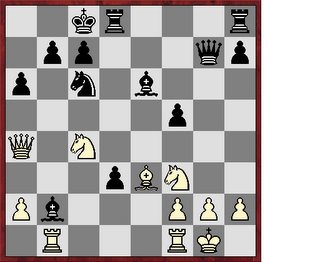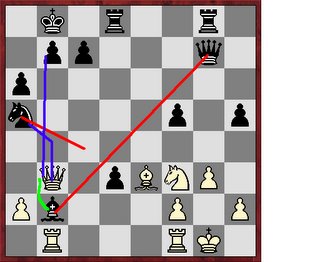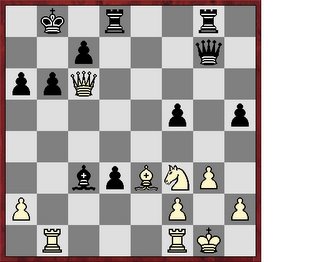A leap in the dark
In the next game I deviated early in the opening from the main line and got myself stuck into a real bad situation. It might be interesting to notice why the side line was a bad choice. Fortunately at our level everything is still possible, and with a bit of luck the killer move might be just around the corner. One thing that I have learned is that I will never play this variation or whatever you may call it again.
Montse (1513) - Tristan,M [C55]
1.e4 e5 2.Nf3 Nc6 3.Bc4 Nf6 4.d4 exd4 5.e5 d5

Main line goes 6.Bb5 Ne4 7.Nxd4 Bd7 8...
I tried something different. I should have known coz someone told me in the past that this was absolutely not good. (Then I did not know why, now I do). Also the variation with 'en passant' capture should be disregarded but this variation I still have to try out. So if I play it, it will not be over the board but against my mechanical brain-wave 'scully'.
6.exf6?! dxc4 7.Qe2+ Be6 8.fxg7 Bxg7

Let's evaluate the position.
After 8 moves black has a lead in development of 5 moves. Pardon me, are you for real? White needs 2 moves to reach its position. Black on the otherhand needs 7 moves to reach this position and is only 2 moves away of completing his development.(castling and activating his Q). White has still his Q-side pieces (R,N, B) in its initial position. He needs 3 moves to complete his development. If we only compare completion of development black is a mere move ahead. But what a position!!
Black has
- the bishop pair which can be very deadly in the open game and in the endgame, (actively placed)
- a semi-open g file to attack white's position. Short castling for white might become very dangerous.
- a pawn shield in white's territory who actually impedes the development of white's knight to it most favorable place (from c3 white has a good control of the small center). The pawns can become a very deadly spear in the hart of white's position.
- the dark squared bishop controls the long diagonal, and is leaning on white its UNDEVELOPPED Q-side. Target: rook a1 (I am your bullet with your name on)
White will have to be very cautious in what order he will develop his pieces. White its dark squared bishop is tied to the defense of b2. C3 would be very unhealthy as you give up the defense for the square d2.
So white its main task is to develop and try to get its pieces out to places with high activity.
Looking at white's fantastic realisation there can only be one 'saying': No worries mate and one 'deed': another mild beer, make it a double.
Playing 9. Ng5 0-0!? and if 10.NxB ... - doesn't look very healthy for white
9.Na3 d3! 10.cxd3 cxd3?!
I tried to create counterplay by attacking c4 as I saw that this pawn was hard to defend. His reply was a breath-taker.
I was forced to exchange the pawn, but did not expect him to recapture with the pawn but instead with the Q. An early Q exchange would be a forced issue and the resulting position I think might be winning for black. Anyway If I refuse to exchange black just go 0-0-0 and yes you got it a torpedo right through your throat (=center).
My opponent decided differently and kept his flagship 'the Bismarck' on the board.

11.Qe4 Qd7 12.0-0 0-0-0
Again my opponent plays a move where he doesn't want to exchange his Q. I expexted Qd5.

White's question was how to develop your bishop with tempo? Answer: Attack a more important piece with your bishop. I attacked his rook with my bishop, so if he cannot find a better threat or move then the move qualifies as sufficient.
Notice it is important for white to keep control over d2! Notice he has a missile to launch with a warhead as Q!! Meaning the Queen is a bad defender of squares, minor pieces and pawns coz of its own strenght and value. So as a direct link to the pawn and acting as a lonesome pusher, I decided he can have his missile. As long as I can defend d2 with my minor pieces and he does not attack my defenders or mobilise his forces to gain control over d2 and the surrounding squares - his battery is just an imaginery force. So momentarily he is looking for the ignition key. No not right, left, I said left.
Judging the position
Black has still a deadlock on White its Q-side, mobilising his h-rook to the g-file (g8) combined for instance with the dark light squared bishop makes the K-side quite vulnerable 1. ... Rg8 2. ... Bh3 3. gxh3 Bxb2+ (with check) 4. K-move and Bishop takes rook on a1. The real goodie is the attack on the rook through an attack on the king.
And then there is the major weakness in the center. This annoying pawn is restricting the mobilty of my pieces.
So black has an enormous advantage although material is even! Positionally speaking this s...s.
So white has no time to loose.
13.Bg5 f6 14.Be3 f5 15.Qa4 a6?! 16.Rac1?! Bxb2 17.Rb1 Qg7 18.Nc4
My little trick for development, followed by Qa4. And this apparently knocked his socks off. Even then Black had such a strong position that he should have been fine. 'a6'I think was not yet necessary. He reacts on a possible threat which is not yet operational. So it has to be classified as a waste of time. His waste of time is my gain in time.
I played Rac1 which actually invites black to take the pawn. My opponent greatly accepts and I thank him by squeezing my rook back to the b-file. In this way I can have a much better look at his King's defense.
An exchange of the bishop for my a3 knight would be best for white as this would immediately eliminate one of his most active pieces.
My opponent decides differently and plays Qg7. Therefor I attack his black bishop a second time. Instead of exchanging immediately he could have played 18. ... Rhg8 which would have been a crushing mate threat.

18.Nc4 Bxc4 19.Qxc4 Rhg8 20.g3

My opponent has seemingly a very comfortable position and decides to open up my pawn shield. He plays h5, with the idea to follow-up with h4 etc...
This was a total wrong assessment of the position and the turning point of the game. Because of the exchanges on c4 my Q has slightly moved towards the center.
21.Qe6+!! the killer move
This move allows white to attack different pieces immediately with check. The weakness of black's position is that the Q is bound to defend the bishop on b2.

21. Qe6+ Qd7 22. QxQ RxQ 23. RxB (piece up +-)
or
21. Qe6+ Rd7 22. RxB QxB 23. QxRg8 (piece up +-)
21.Qe6+! Kb8 22.Qb3! Na5
Now his Bishop is 2 times attack with a battery along the b-file. His Bishop is lost.

In the game I looked at 20. ... Qg4, with his Q attacking my knight but seemingly Prof Fritz likes 20... Qc3 even more. I agree.
23.Qb4?? Bc3 24.Qc5 Nc6?? 25.Qxc6 b6
And now It became messy - 'A' grade real patzer chess. One blunder follows the other. We all love it when it happens to our opponent. I started, he must have been in shock. Convinced he could do better he puts his Knight 'en prise'. I was baffled, got myself another beer & cooled down a bit. Eventually I looked him in the eye and smiled. Life can be great!
So why did I not play 23.Qxb2.QxQ 24. RxQ Nc4 25. Rb3 or Rb1. I calculated it correctly but then started to look for a move without allowing to have him a fork. I decided that he might have some counterplay but this was a wrong assessment. So I looked to Qb4 and saw a double threat which I thought was equivalent. Attack on Bishop by rook and an attack on Knight and Bishop by my Q. Also the battery was intact on b7 so everything seemed to be in order. Unfortunately I did not see Bc3! and with this move all my threats were covered.
Eventually the following position was reached which is typically CT-art orientated. Please restrain yourself a little bit.
Have a go!

solution: way below
26.Bxb6!! cxb6 [#3 Fritz 7: 26...Kc8 27.Bd4 Bxd4 28.Qe6+ Rd7 29.Qxa6+ Kd8 30.Rb8+ Ke7 31.Re1+ Qe5 8.53/9 ] 27.Rxb6+ Ka7 28.Rxa6+ Kb8 29.Ra8# 1-0
Montse (1513) - Tristan,M [C55]
1.e4 e5 2.Nf3 Nc6 3.Bc4 Nf6 4.d4 exd4 5.e5 d5

Main line goes 6.Bb5 Ne4 7.Nxd4 Bd7 8...
I tried something different. I should have known coz someone told me in the past that this was absolutely not good. (Then I did not know why, now I do). Also the variation with 'en passant' capture should be disregarded but this variation I still have to try out. So if I play it, it will not be over the board but against my mechanical brain-wave 'scully'.
6.exf6?! dxc4 7.Qe2+ Be6 8.fxg7 Bxg7

Let's evaluate the position.
After 8 moves black has a lead in development of 5 moves. Pardon me, are you for real? White needs 2 moves to reach its position. Black on the otherhand needs 7 moves to reach this position and is only 2 moves away of completing his development.(castling and activating his Q). White has still his Q-side pieces (R,N, B) in its initial position. He needs 3 moves to complete his development. If we only compare completion of development black is a mere move ahead. But what a position!!
Black has
- the bishop pair which can be very deadly in the open game and in the endgame, (actively placed)
- a semi-open g file to attack white's position. Short castling for white might become very dangerous.
- a pawn shield in white's territory who actually impedes the development of white's knight to it most favorable place (from c3 white has a good control of the small center). The pawns can become a very deadly spear in the hart of white's position.
- the dark squared bishop controls the long diagonal, and is leaning on white its UNDEVELOPPED Q-side. Target: rook a1 (I am your bullet with your name on)
White will have to be very cautious in what order he will develop his pieces. White its dark squared bishop is tied to the defense of b2. C3 would be very unhealthy as you give up the defense for the square d2.
So white its main task is to develop and try to get its pieces out to places with high activity.
Looking at white's fantastic realisation there can only be one 'saying': No worries mate and one 'deed': another mild beer, make it a double.
Playing 9. Ng5 0-0!? and if 10.NxB ... - doesn't look very healthy for white
9.Na3 d3! 10.cxd3 cxd3?!
I tried to create counterplay by attacking c4 as I saw that this pawn was hard to defend. His reply was a breath-taker.
I was forced to exchange the pawn, but did not expect him to recapture with the pawn but instead with the Q. An early Q exchange would be a forced issue and the resulting position I think might be winning for black. Anyway If I refuse to exchange black just go 0-0-0 and yes you got it a torpedo right through your throat (=center).
My opponent decided differently and kept his flagship 'the Bismarck' on the board.

11.Qe4 Qd7 12.0-0 0-0-0
Again my opponent plays a move where he doesn't want to exchange his Q. I expexted Qd5.

White's question was how to develop your bishop with tempo? Answer: Attack a more important piece with your bishop. I attacked his rook with my bishop, so if he cannot find a better threat or move then the move qualifies as sufficient.
Notice it is important for white to keep control over d2! Notice he has a missile to launch with a warhead as Q!! Meaning the Queen is a bad defender of squares, minor pieces and pawns coz of its own strenght and value. So as a direct link to the pawn and acting as a lonesome pusher, I decided he can have his missile. As long as I can defend d2 with my minor pieces and he does not attack my defenders or mobilise his forces to gain control over d2 and the surrounding squares - his battery is just an imaginery force. So momentarily he is looking for the ignition key. No not right, left, I said left.
Judging the position
Black has still a deadlock on White its Q-side, mobilising his h-rook to the g-file (g8) combined for instance with the dark light squared bishop makes the K-side quite vulnerable 1. ... Rg8 2. ... Bh3 3. gxh3 Bxb2+ (with check) 4. K-move and Bishop takes rook on a1. The real goodie is the attack on the rook through an attack on the king.
And then there is the major weakness in the center. This annoying pawn is restricting the mobilty of my pieces.
So black has an enormous advantage although material is even! Positionally speaking this s...s.
So white has no time to loose.
13.Bg5 f6 14.Be3 f5 15.Qa4 a6?! 16.Rac1?! Bxb2 17.Rb1 Qg7 18.Nc4
My little trick for development, followed by Qa4. And this apparently knocked his socks off. Even then Black had such a strong position that he should have been fine. 'a6'I think was not yet necessary. He reacts on a possible threat which is not yet operational. So it has to be classified as a waste of time. His waste of time is my gain in time.
I played Rac1 which actually invites black to take the pawn. My opponent greatly accepts and I thank him by squeezing my rook back to the b-file. In this way I can have a much better look at his King's defense.
An exchange of the bishop for my a3 knight would be best for white as this would immediately eliminate one of his most active pieces.
My opponent decides differently and plays Qg7. Therefor I attack his black bishop a second time. Instead of exchanging immediately he could have played 18. ... Rhg8 which would have been a crushing mate threat.

18.Nc4 Bxc4 19.Qxc4 Rhg8 20.g3

My opponent has seemingly a very comfortable position and decides to open up my pawn shield. He plays h5, with the idea to follow-up with h4 etc...
This was a total wrong assessment of the position and the turning point of the game. Because of the exchanges on c4 my Q has slightly moved towards the center.
21.Qe6+!! the killer move
This move allows white to attack different pieces immediately with check. The weakness of black's position is that the Q is bound to defend the bishop on b2.

21. Qe6+ Qd7 22. QxQ RxQ 23. RxB (piece up +-)
or
21. Qe6+ Rd7 22. RxB QxB 23. QxRg8 (piece up +-)
21.Qe6+! Kb8 22.Qb3! Na5
Now his Bishop is 2 times attack with a battery along the b-file. His Bishop is lost.

In the game I looked at 20. ... Qg4, with his Q attacking my knight but seemingly Prof Fritz likes 20... Qc3 even more. I agree.
23.Qb4?? Bc3 24.Qc5 Nc6?? 25.Qxc6 b6
And now It became messy - 'A' grade real patzer chess. One blunder follows the other. We all love it when it happens to our opponent. I started, he must have been in shock. Convinced he could do better he puts his Knight 'en prise'. I was baffled, got myself another beer & cooled down a bit. Eventually I looked him in the eye and smiled. Life can be great!
So why did I not play 23.Qxb2.QxQ 24. RxQ Nc4 25. Rb3 or Rb1. I calculated it correctly but then started to look for a move without allowing to have him a fork. I decided that he might have some counterplay but this was a wrong assessment. So I looked to Qb4 and saw a double threat which I thought was equivalent. Attack on Bishop by rook and an attack on Knight and Bishop by my Q. Also the battery was intact on b7 so everything seemed to be in order. Unfortunately I did not see Bc3! and with this move all my threats were covered.
Eventually the following position was reached which is typically CT-art orientated. Please restrain yourself a little bit.
Have a go!

solution: way below
26.Bxb6!! cxb6 [#3 Fritz 7: 26...Kc8 27.Bd4 Bxd4 28.Qe6+ Rd7 29.Qxa6+ Kd8 30.Rb8+ Ke7 31.Re1+ Qe5 8.53/9 ] 27.Rxb6+ Ka7 28.Rxa6+ Kb8 29.Ra8# 1-0


0 Comments:
Post a Comment
<< Home